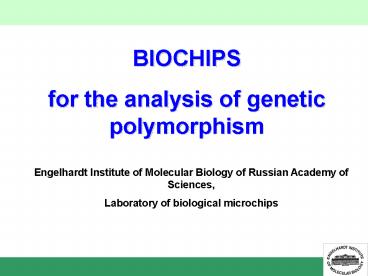BIOCHIPS - PowerPoint PPT Presentation
1 / 8
Title:
BIOCHIPS
Description:
High level of discrimination between positive signals and background ... Angiotensin converting enzyme. Angiotensinogen. Angiotensin II receptor type I ... – PowerPoint PPT presentation
Number of Views:489
Avg rating:3.0/5.0
Title: BIOCHIPS
1
BIOCHIPS for the analysis of genetic polymorphism
Engelhardt Institute of Molecular Biology of
Russian Academy of Sciences, Laboratory of
biological microchips
2
Overview of Gel-based Biochip Technology
- High probe concentration due to high
immobilization capacity - High fluorescence signal and the possibility to
use simple and cheap detecting system - High level of discrimination between positive
signals and background
Gel-based technology has been developed in EIMB
since 1989
3
Biochips developed in EIMB allow to identify and
analyze
- Tuberculosis causative agent and its drug-
resistance (49 mutations)
certified and used in Russia - Chromosome rearrangements in oncological diseases
of blood certified and used in Russia - Genetic predisposition to oncological diseases
and individual tolerance of certain medications
certified and used in Russia - Genetic markers of an individual (in forensic
studies) in the process of certification
4
Leukemia-biochip to diagnoze 13 most common
chromosomal translocations in leukemia
t(1517) bcr3
Translocation 11q23, poor prognosis bone marrow
transplantation is required.
95 AML-?3, specific therapy with all-trans
retinoic acid (ATRA).About 95 recover.
501 ALL patients (24.4)
201 AML patients (36.4)
Oncological diseases the cause of 30 deaths in
Russia
5
Hereditary breast cancer biochip
to diagnoze inherited point mutations in breast
cancer patients and family members
Wild type
gene mutation allele frequency
risk increase
185delAG 0.8 n 4
BRCA1
breast cancer by 50-80
300TgtG 0.2, n1
4153 delA 0.4, n2
4158AgtG 1.0, n5
185delAG
5382insC 3.3, n16
ovarian cancer by 20-60
BRCA2
6174delT 0.2, n1 695insT 0.2, n1
CHEK2
1100delC 1.7, n1
Breast cancer affects approximately 1 women in 10
and up to 10 of the cases are due to inherited
predisposition.
6
Pharmagen-biochip
is designed to analyse genes of metabolyzing
enzymes
Applications
CYP1A1 (2A/1) (1) increased activity of the
enzyme, forming metabolites harmful for
DNA CYP2D6 (1/1), GSTT1 (-/-) (2) GSTM1 (-/-)
(3) absence of the enzymes neutralizing toxic
metabolites. NAT2 (S1/S3) (4) low speed of
acetylation of toxic metabolites MTHFR (C/C),
CYP2C9 (2/1) (5) low activity of the enzyme
CYP2C19 (1/1)
- Pharmacogenetic profile
- clinical testing for individual sensitivity
to several drugs (thiopurines,varfarin,omeprazol
and so on)
- Population-based association
- studies
(CYP1A1, CYP2D6, GSTM1, GSTT1, NAT2, MTHFR,
CYP2C9, CYP2C19, TPMT and NQO1)
7
Vascular diseases
arterial hypertensia, myocardial infarction,
arterial and venous thromboses, ishemic disease.
Hemostasis Factor V MTHFR GP IIb/IIIa Factor
VII PAI-1 Fibrinogen
Genes of interest
Blood pressure Renin Angiotensin converting
enzyme Angiotensinogen Angiotensin II receptor
type I Angiotensin II receptor type I Bradikinin
receptor type II Beta adrenoreceptor type
1 Beta-adrenoreceptor type 2
Lipid metabolism Apolipoprotein-E LPL Apo-B
55 Russians die from cardiovascular diseases
8
Perspectives
- neurological diseases, such as neurotrauma,
stroke, dementia - prenatal diagnostics
- cystic fibrosis
- immunohistocompatibility testing
- predisposition to diabetis
- predisposition to osteoporosis
- prognosis of cervical cancer.
Biochip is an effective tool analysis of SNPs and
mutations































